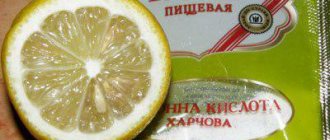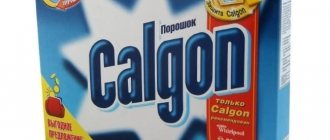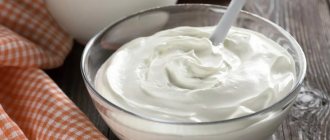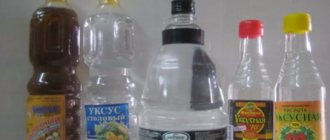To answer the question of whether it is possible to replace lemon with citric acid, it is necessary to clarify for what purpose the replacement is being made. If it is for health improvement and obtaining an identical taste, then no. But in the preparation of most dishes, lemon and citric acid are completely interchangeable components. In cooking, they are used to give foods a pleasant flavor. In addition, acids play the role of preservatives and help maintain the attractive appearance of dishes. They are often used for marinating meat and fish.
Advantages and disadvantages of replacing juice with acid
Lemon contains many beneficial substances and aromatic essential oils. Its main advantage is its benefits to the body. It has tonic properties, improves immunity, improves memory and prevents inflammatory processes.
Lemon and citric acid have only one similarity - a sour taste. "Limonka" is a chemical product. It is obtained through the biosynthesis of sugary substances. Although previously it was actually obtained from citrus fruits.
Pros of using citric acid in dishes:
- low cost;
- compactness;
- long shelf life;
- versatility;
- good solubility in any liquid;
- Allowed for people with allergies to citrus fruits.
“Limonka” loses to juicy citrus only in several respects:
- has a sour, but completely unnatural, unpleasant taste;
- has no smell;
- does not contain vitamins and nutrients.
A pack of citric acid (25 grams) can replace 4-5 lemons, which is equivalent to 150 ml, or 10 tbsp. l, juice.
Table vinegar (9%) can be replaced with apple cider vinegar.
But you need to understand that apple cider vinegar is sold at 5%, that is, to use it instead of 9% vinegar, you will need 2 times more apple cider vinegar. Instead of 1 tablespoon of 9% vinegar, take 2 tablespoons of apple cider vinegar.
Apple cider vinegar, grape (wine), rice vinegar, balsamic vinegar and others are most often used NOT for canning, but for dishes (borscht, salads, dressings) or marinating meat and fish. Since they still have their own specific taste, introduce them into your family’s diet carefully, because as you know, we are often conservative in our tastes, especially children.
You need to be even more careful if someone in the family has gastritis, ulcers or colitis, as well as
When is it possible?
Lemon juice can be replaced with acid from a pack if the dish is planned to be heat treated. With strong heating, beneficial substances still evaporate from the juice. The only thing is that the dish will not have a lemon smell. But this will not affect the taste at all.
Add “lemon” instead of lemon juice:
- in marinades for fish and meat;
- in jam;
- in mousses and creams;
- in syrups and sauces;
- in meringues, fondants;
- into baking dough;
- in soft drinks.
We recommend: How to distinguish edible mushrooms from poisonous ones?
But it is not recommended to spray prepared dishes with the solution. This will not have the best effect on the taste.
Sauces and dressings
Citric acid, as an excellent preservative, is often added to factory-made ketchups, tartar and other sauces. By cooking at home and not needing long-term storage, you can abandon the artificial product in favor of natural juices. An ideal substitute is lemon squeeze or apple cider vinegar, which has some sweetness. Also, depending on the composition of the sauce, other ingredients are used, for example, whey.
- To make the gravy more sour, add tomato paste, sumac seasoning, and sorrel.
- Lime and grapefruit juices will refresh the taste of salad or baked meat.
- If you need to add a piquant sweet and sour note, fruit and berry juices are suitable: red currant and cherry plum in the summer, apple, pomegranate, cranberry and viburnum in the fall.
In sauces based on cream or soy concentrate, you can safely add rice wine or the same vinegar.
Proportions for replacement
It is impossible to calculate exactly how much “lemon” you need to take so that its acidity matches the juice of one lemon. Firstly, citrus fruits come in different sizes, and secondly, they differ in juiciness and thickness of the peel. Thirdly, some varieties are very sour, others are more watery. Therefore, all calculations of proportions will be approximate:
- 100 ml lemon juice = 100 ml water and 16 g citric acid.
- Juice of one lemon = 30–40 ml of water and 5 g of lemon juice (teaspoon).
- 1 tbsp. spoon of lemon juice = 1 tbsp. a spoonful of water and 0.5 teaspoons of lemon.
It is advisable to taste the diluted liquid. If it is not sour enough, add lemon. And if it’s the other way around, add water.
You definitely shouldn’t replace lemon with acid to boost immunity or improve health. It does not benefit the body and in high doses can cause irritation of the mucous membranes, burns, stomach pain, burning, and nausea.
How to dilute vinegar essence? (to get vinegar)
How to dilute vinegar from 70% vinegar essence:
9% vinegar , you need to take one part of the essence and add seven parts of water (1 tablespoon of essence and 7 tablespoons of water)
6% vinegar - add 11 parts of water to one part of essence (1 tablespoon of essence and 11 tablespoons of water)
5% vinegar - add 13 parts water to one part essence (1 tablespoon essence and 13 tablespoons water)
4% vinegar - add 17 parts of water to one part of essence (1 tablespoon of essence and 17 tablespoons of water)
3% vinegar - add 23 parts water to one part essence (1 tablespoon essence and 23 tablespoons water)
So, if you need 1 tablespoon of 70% vinegar essence, but you only have 5% vinegar, and its concentration is 13 times less, then you need to add 13 tablespoons of 5% vinegar.
Another point to consider is that if the recipe says 1 tablespoon of vinegar essence 70%, and you replace the essence with vinegar in the required proportion, then take not 1 liter of water, but several tablespoons less. That is, 5% vinegar 7 tablespoons and MINUS 13 tablespoons of water.
If you need to add 1 tablespoon of 70% vinegar essence, and you only have 9% vinegar, then you need to add 7 tablespoons of 9% vinegar.
Other lemon substitutes
Citric acid is not the only substitute for lemon. If you don’t have either one or the other at hand, you can successfully use:
- sour berries (red currants, lingonberries, cranberries);
- sorrel;
- oranges and tangerines;
- pomegranate, cherry, cranberry, apple, grape juice without sugar;
- table, apple or wine vinegar;
- lemon pepper (when cooking fish).
Natural substitutes are rich in bioactive substances and are beneficial for health. Most often, instead of lemon in cooking, 9% table vinegar is used: 4 teaspoons replace the juice of 1 lemon or 1 teaspoon of lemon juice.
So, can you replace lemon with citric acid? In cooking, definitely yes. Both components add sourness, make meat and fish juicy, and prevent sweet creams and jam from crystallizing. When replacing, be guided by the above proportions and taste the solution to get the desired percentage of acidity.
We recommend: How to properly clean flounder before frying, baking or stewing?
How is citric acid used?
Sourness in cooking is a significant note in the taste palette; it is necessary in marinades, salads and stews, sauces, fruit desserts, and drinks. Most often, acid is used in meat, vegetable and fruit dishes. It is especially important in desserts so that they are not cloying, to imitate natural fruit flavors and aromas, as well as when pickling foods to preserve them or make them softer and more tender. In addition, the substance is used to extinguish soda in the process of preparing dough, soufflés and drinks.
Citric acid has become a universal remedy in the kitchen in this regard. It is harmless to the body, has no color or odor, and can be added to main and sweet dishes. At the same time, the powder is concentrated and consumed economically. An additional advantage is that it dissolves easily in liquid. But citric acid is not always on hand, so there are several options for replacing the additive.
Here is a general list of products with similar properties:
- table, fruit, rice, balsamic vinegar;
- dry wine;
- juices of lemon, lime, grapefruit, cranberry, viburnum;
- tomato paste;
- serum;
- ready-made brine;
- Apple acid.
Now let’s take a closer look at which dishes you can add the listed components to.
Recommendations for taking the tincture
The most important thing in treatment with folk remedies is the correct dosage. Exceeding the optimal dose destroys the therapeutic effect of the drug and leads to harmful consequences
Vessel cleaning scheme:
- 1 day – 1 drop 3 times a day;
- Day 2 – 4 drops for 1 dose, 5 drops for 2, 6 drops for 3;
- Day 3 – 7 drops on 1, 8 – on 2, 9 – on 3;
- On days 4 and 5, continue in the same way, increasing the dose by 1 drop per dose, reaching 15 by the end of day 5.
After 3 days you need to take a break for 1 week and observe how you feel. For diabetes mellitus, honey can be used in consultation with your doctor. After a break, you can repeat the course if there are positive changes.
Fruit juices
To prepare the marinade, you can use any juices (berry or fruit). Such drinks are characterized by a high content of ascorbic acid. We list the main types of juices that are ideal for replacement:
- Apple;
- Cranberry;
- Lingonberry;
- Currant;
- Sea buckthorn.
In addition to juices, berry concentrates are a good solution. The only recommendation concerns the composition. Before adding the product, make sure there is no sugar. If you are kneading the dough for dessert, add any citrus zest.
Subtleties of cooking
- The water for okroshka needs to be boiled in advance and then cooled. Those housewives who use raw water for okroshka act short-sightedly, believing that citric acid will kill microbes. Raw water mixed with fresh cucumbers may cause stomach upset. And okroshka made from raw water is stored much worse.
- In order not to overdo it with citric acid, it should be diluted in a small amount of boiled water and then added to the dish at the very end of cooking. All ingredients at that time must be mixed together and combined with liquid - water mixed with mayonnaise or sour cream.
- Citric acid can be diluted in the full volume of water, adding enough of it so that the water acquires a pleasant sour taste. After this, the chopped vegetables are diluted with water in the same way as they do with kvass.
- Okroshka with citric acid is prepared according to the standard procedure. Vegetables and other foods should be cut into equal pieces: cubes, strips or slices. Then the okroshka will look more appetizing, and the ingredients will combine better with each other.
Note to the hostess
Table for obtaining solutions of various concentrations
| Parts ratio (essence:water) | Solution concentration |
| 1:22,5 | 3% |
| 1:17 | 4% |
| 1:13 | 5% |
| 1:11 | 6% |
| 1:9 | 7% |
| 1:8 | 8% |
| 1:7 | 9% |
| 1:6 | 10% |
| 1:1,5 | 30% |
Vinegar added to water will prolong the life of a festive bouquet of flowers, drive cockroaches out of the house and stop hiccups, give dishes a unique taste and make hair smooth and shiny... This is a real miracle that came from time immemorial, but has not lost its relevance in the modern world!
Vinegar is something that every housewife has in her kitchen, who cannot do without it when preparing most culinary masterpieces. However, it also happens that it is not available at home, but 70% vinegar essence is available. This is a concentrated liquid where the acid to water ratio is 7:3.
More often in stores you can find a 70% solution, but you can also see 80% and 30% acetic acid. All these liquids are unsafe and should never be taken in their pure form. If it enters the body, the mucous membranes receive severe burns. So, in the absence of ready-made table vinegar, there is a concentrate that needs to be diluted, but few know to the required percentage.
It is worth noting that the product is very practical in everyday life. From 1 tsp. you can get a whole glass of the usual vinegar!
Choosing quality vinegar essence
Basic Rules:
- The liquid is bottled in glass bottles, transparent in color, without sediment.
- Label composition. The natural solution includes only water and 99% acid.
- Shake the bottle - the acid will begin to foam, then quickly settle. If the foam remains at the top, this is a sure sign of unnaturalness.
Why should you pay attention to this? When diluting the fake, you will get vinegar that is not the right percentage
Safety precautions when diluting
Incorrect or careless use of vinegar essence can negatively affect the body - cause poisoning or burns of mucous membranes and organs. To avoid getting into trouble, you should follow the rules:
When purchasing a solution, pay attention to the label with information about it and the concentration. Under no circumstances should you try the product in its pure form. Do not inhale acetic acid vapors; it may damage the mucous membranes of the respiratory tract. If you feel slight irritation in your nose and larynx, you should gargle with cool water or inhale with baking soda. In case of contact with eyes, rinse them immediately with water. In case of contact with skin, wash skin with soap and water. In case of poisoning, call an ambulance and rinse the stomach. Do not induce a gag reflex under any circumstances! Store the bottle of essence where children cannot reach it.
Dilution of vinegar essence to 9% and 6%
Let's imagine that you need 9% vinegar when preparing a dish, but you only have a concentrate that needs to be diluted. There is no need for magical abilities in this matter; you just need knowledge on this topic, which will be provided right away.
- The first thing you need is a glass container, for example, a glass or bowl
- Next, cold water is poured into the bowl, then the essence, exactly in this sequence
- Now the main thing is that with acetic acid at 70%, you need to take 7 servings of water (7 tablespoons) and 1 serving of concentrate (1 tablespoon)
- Result – 9% table vinegar
This technique can be done to get 6% vinegar:
You will need 10.5 tablespoons of water and 1 tablespoon of vinegar essence
Well, now it’s clear how to dilute vinegar essence
. Since some people may end up with 80% and 30% solutions, we will provide a calculation table below so as not to write down and, moreover, it is easy to remember.
A short educational excursion into history
Vinegar has been known to man since ancient times. It was obtained by fermenting wine, the favorite drink of the god Dionysus. This probably happened by accident, perhaps when one of the husbands forgot his vessel with a drink in the scorching sun.
The very first vinegar was made about 7,000 years ago from date wine in Ancient Egypt and Babylon. Used as an antiseptic and solvent in medical solutions.
These are some interesting facts, did you know about them?
So, having considered how to
dilute vinegar essence
at home, you don’t have to worry now that if you don’t have table vinegar on hand, you’ll have to run to the store to buy it.
It is important to know
You definitely need to remember that the shelf life of vinegar essence or simple natural vinegar is different. While the acid will not lose its properties for more than ten years, the natural product should only be used for a few years. After this period, the beneficial properties disappear, even if the vinegar looks quite suitable for use. It is not recommended to use the essence in mustard preservation recipes. Such a mixture can spoil the workpiece even before it is sent for storage. Instead, it is better to choose a different recipe or use simple table vinegar. Acetic acid is a residue from the production of fertilizers from natural gas or sawdust. Before using the product in preparations, you need to think several times whether preservation with such an ingredient will be useful. Even if the contents of a glass container are stored for several years, you should not risk your health when serving your favorite pickled vegetables. If you cannot do without preparing acetic acid, you need to store it out of the reach of small children.
Such a concentrated product can cause a painful, extensive burn in a child if it comes into contact with the skin, and if ingested, it can be fatal. Working with acid requires special attention and caution. If it gets on the skin, immediately rinse the injured area with cold water. If the damage is serious, consult a doctor immediately.
General principles for making lemon sauce
To prepare sauces, lemon zest and juice are usually used; pulp is rarely added. Seeds should always be removed from the fruit. The juice is usually squeezed by hand, since according to the recipe, 1-2 citrus fruits are enough.
If it is important that nothing unnecessary gets into the sauce, strain the squeezed mass through a strainer
Peel the lemon zest in a thin layer, without the white part, using a sharp knife or fine grater. First, the citrus needs to be washed well with a brush and the peel is doused with boiling water. In order for the lemon to release its juice well, it should be kept in hot water for several minutes, then rolled well on the table, after which you can cut it in half and squeeze it out.
The color of lemon sauce is easy to change. To color the dressing, use carrot or beet juice, turmeric, chopped fresh herbs, and soy sauce. The resulting product should be stored in a tightly sealed glass container for no more than 3 days in the refrigerator.
Natural vinegar
Natural types of vinegar are obtained from apples, grapes, and other fruits that contain the necessary acids. The label of such a product certainly contains information that allows you to find out what exactly is contained in the container.
If “Natural” or “Biochemical” is indicated, you can safely purchase the product without fear for the health of your loved ones.
A small amount of cloudy sediment at the bottom of the container with vinegar should not worry: this is inevitable, because the product is completely natural. Such a product cannot contain more than 9% acid; if, when purchasing fruit vinegar, the label says otherwise, it is better to refrain from purchasing a questionable liquid, this may not only be detrimental to the contents of the jars, but also cause harm to health.
Summarize
- There are several ways to substitute lemon juice in cooking and baking.
- However, lime juice is the most ideal substitute as it is very similar to lemon juice.
- Keep in mind that when using a powdered or highly concentrated lemon juice substitute such as citric acid or lemon extract, you may need to add additional liquid to maintain the correct wet-to-dry ratio.
- The above lemon juice substitutes will ensure that you can continue cooking despite the lack of lemon juice.











